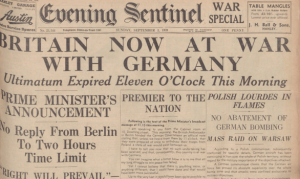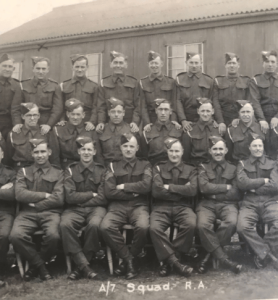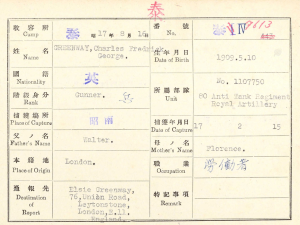With VJ Day at the forefront of our thoughts, we highlight a community story and key steps for researching your ancestors who served in the Far East during WWII.
What is VJ Day?
VJ Day is recognised on 15 August each year and is an important date in the calendar of WWII commemorations. Marking the date Japan announced its surrender during WWII (15 August 1945), VJ Day offers a time for reflection on the sacrifices made by British and Allied forces during the fighting in the Far East. Although the official Japanese surrender was signed on 2 September, the announcement of 15 August effectively ended WWII, bringing to a close almost six years of global conflict.
Community story
When community member John Smith told us about his wife’s uncle Charles Greenway, a prisoner of war in the Far East during WWII, we couldn’t resist delving into the records to learn more. Read on as we explore Charles’s story and provide some hints and tips for researching ancestors who served in the Far East during WWII.
Charles Frederick George Greenway (1909-1990)
Charles was born on 10 May 1909 in West Ham, then part of Essex, but now in the boundaries of London. Shortly before his second birthday, Charles was recorded in the 1911 census as living with his parents and five siblings in Stratford, east London. Charles’s father was a confectionary dealer and insurance agent at this point. Charles married Elsey Impey in Victoria Park, London, in 1934.

War descends on Europe
On 3 September 1939, Britain declared war on Germany. For the second time in the 20th century, Europe was engulfed by armed conflict. For many, the horrors of WWI were still fresh in their memory. Britain immediately introduced the National Service Act. The act made all males between 18 and 41 years old liable for military service, requiring them to register for service. Single men were called up first, which explains why we see Charles with his wife in the 1939 Register, which was taken on 29 September 1939.
FWR Tip: Can’t find your ancestor in the 1939 Register? The register does not include the military, although there are some anomalies. If your ancestor was of military age and doesn’t appear in the register, they could have been called up or enlisted for service.
Charles’s time would eventually come, and he enlisted in the British Army on 16 January 1941.
A starting point
John shared some useful information about Charles, including a summary of his movements from a source known as the Liberated Prisoner of War Interrogation Questionnaires (more on this fascinating collection later). John established when Charles was captured, the regiment he served with and many of the camps he was held at, but echoed a sentiment felt by many with family members who were POWs:
‘Unfortunately, I do not have very much information as Charles, like so many who returned, never spoke about their experiences.’

Searching for Charles
Targeting specific record collections is often a logical way of researching an ancestor, but you may not know which collection to search first or which collections are at your disposal.
You can start your search for military ancestors by entering their names into the Forces War Records website. Try adding their number or regiment/unit, if you know it, to help narrow your results. We’ve created a handy video on how to begin your search.
FWR Tip: Some collections refer to individuals by their initials only. When searching for military ancestors, particularly those with multiple first names, try searching Forces War Records using their initials. Here are some examples from our research into Charles: ‘Greenway, CFG’ and ‘Greenway, C.F.G.’
If Charles was my ancestor, where would I head next in the quest for information? Undoubtedly, it would be his service record.
Service records
There are many collections available to help research WWII military ancestors. However, it is a challenging conflict to research owing to its relative closeness in history and the data protection laws surrounding certain records.
The ultimate record for researching a military ancestor is their service record. Comprising valuable military and biographical information, they can help you gain a detailed insight into your ancestors’ military service. When did they enlist? Who did they serve with? Where did they serve? Were they wounded? Did they receive a promotion? Did they have any previous military experience? What medals were they entitled to? These are the kind of questions a service record could help you to answer.
Service records of other ranks (not officers) who served with the British Army from January 1921 onwards are held by the Ministry of Defence (MOD). At the time of writing, British Army service records are in the process of transfer to The National Archives (TNA) in Kew. You can apply online for service records via the MOD website. There is also an option to apply through TNA’s website; we advise applying through both during this early stage of the transfer project. There is, however, a lengthy wait for records owing to the high demand for service records and the infancy of the project.
Are there other records you can search while you wait for a service record? Here’s what we found on Charles when searching Forces War Records.
FWR Tip: The ‘Service and Casualty Form’ pages of a British Army service record can help you piece together your ancestor’s movements and the units they served with.
Prisoner of war collections
The prisoner of war story is a common feature of many of our ancestors’ WWII experience, particularly if they served in the Far East. Estimates suggest the Japanese took 140,000 to 190,000 British and Allied prisoners during WWII. Amongst the captives was Charles Greenway.
Information supplied by John indicates that Charles was captured in Malaya on 15 February 1942, when Singapore fell to the Imperial Japanese Army. Approximately 80,000 British and Allied troops were rounded up by Japanese forces, leading the Prime Minister Winston Churchill to describe it as ‘the worst disaster and largest capitulation in British history’.
Our WWII Daily Reports collection, comprising reports on casualties at different stages of the war, sheds further light on Charles’s fate following Singapore’s capitulation. An initial War Office Casualty Section report, dated 6 April 1942, noted that Charles was ‘missing’ in Malaya as of 15 February 1942. He was a Gunner with the 80th Anti-Tank Regiment of the Royal Artillery, and his number was 1107750. The confusion and lack of information following the Allied defeat at Singapore is emphasised in Charlses’s ‘missing’ status.
A second report was filed on 13 October 1942, confirming that Charles was no longer deemed to be missing and was a prisoner of war; his family’s wait for information must have been agonising.
FWR Tip: Reports may be dated much later than the actual incident they concern, owing to the delays in receiving information, particularly regarding POWs in the Far East.

Often with military research, and particularly when researching POWs, you are required to consult multiple records and collections, each offering a different piece of the puzzle.
Continuing our research into Charles’s wartime service, we unearthed multiple entries in our Allied Prisoners of War, 1939-1945 collection. A highlight of this collection is the informative and visually impressive Japanese index cards. Charles’s card contains valuable military and genealogical details while also confirming that he was captured on 15 February 1942. Often you will need to translate the Japanese symbols or dates printed on the cards.
FWR Tip: Check out our Researching a WWII prisoner of war blog for a closer look at WWII prisoner of war records and how to interpret the Japanese index cards. In addition, The National Archives of the Netherlands has created a useful document for deciphering the symbols on the index cards.
You may encounter multiple entries for your ancestor in the Allied Prisoners of War, 1939-1945 collection; we discovered many for Charles when exploring his service. Each entry may provide a different piece of the puzzle, like when the person was captured, the camp or camps they were held at, if they were named on a casualty list and perhaps when they were repatriated.
We know from John’s notes that Charles was taken to Changi camp, the notorious prisoner of war camp in northeast Singapore. Other entries in the Allied prisoner of war collection noted that:
- Charles was included in a party of men transferred overland from Singapore on 20 June 1942.
- His name appears on a roll of Allied prisoners of war held in Thailand. It would appear he was working on the infamous Burma-Thailand Railway.
- He was liberated from Thailand on 2 September 1945, when Japan officially signed its surrender.
For further avenues of research into WWII prisoners, Forces War Records subscribers have access to additional Far East prisoner of war collections:
FWR Tip: While you may find repeated information from one prisoner of war collection to the next, you never know what you will find until you check your ancestor’s entry. One key clue or snippet of information contained in an entry could help you make a breakthrough.
What other steps could we take to learn about Charles’s service?
Additional steps
Liberated Prisoner of War Interrogation Questionnaires
John kindly provided us with a transcript of Charles’s entry in the Liberated Prisoner of War Interrogation Questionnaire collection. The questionnaires form part of a valuable collection for military genealogists researching prisoners of war during WWII and are now available on Ancestry (the originals are held at TNA).
Around 140,000 Allied prisoners were interviewed between 1945 and 1946, following their release from captivity at the end of WWII. In addition to providing basic military and genealogical information, the person’s date of enlistment is provided. This represents a valuable entry in the timeline of your ancestor’s military service.
Each individual was asked to provide the names of the camps they were held at and their dates of incarceration; this section complements the existing POW collections available on Forces War Records. Other questions were asked of the POWs, for example, if they had attempted escape, although escape attempts were less common in the Far East when compared with Europe. Charles’s entry in the collection provides valuable insight into the camps he was held at and his dates of incarceration.
War diaries
British Army war diaries are an excellent source for adding contextual information to your ancestor’s military service. During WWI and WWII, each battalion or unit was required to keep a diary, offering a fascinating insight into their day-to-day activities and helping us to understand what our ancestors were experiencing throughout their service. The diaries may help to shed light on the day they were wounded, when they were awarded for bravery or when they were taken prisoner.
WWII war diaries are held at TNA. The diaries for Charles’s unit, the 80th Anti-Tank Regiment or the Royal Artillery, have not survived after October 1941 and were most likely lost following the Japanese conquest of Singapore.

Researching the fallen
Charles survived the war and died in 1990, but close to two hundred of his comrades from his regiment did not return home. They were either killed in action or died in captivity and are buried in cemeteries or commemorated on memorials across south-east Asia.
Whether they were killed on the battlefield or died in captivity, you can learn more about those who lost their lives through our WWI & WWII, Commonwealth War Graves Commission Death Registers. In addition to key military details, entries often provide next-of-kin information. This is especially important if you are researching an ancestor with a common name and you are struggling to identify them in the records. The addition of a parent or spouse’s name or address can help you positively identify your ancestor.
This VJ Day, we will be remembering Charles and all the men and women who served during WWII.
We would like to thank community member John Smith for sharing Charles’s story with us.
Sources
Imperial War Museums, What Life Was Like For POWs In The Far East During The Second World War, accessed August 2023.
Jonathan Fennell, Fighting the People’s War: The British and Commonwealth Armies and the Second World War (Cambridge, England: Cambridge University Press, 2019).
National Army Museum, The Far East campaign, accessed August 2023.
Royal British Legion, Far East Prisoners of War, accessed August 2023.
UK Parliament, Conscription: the Second World War, accessed August 2023.


